Art World
Renoir’s ‘Luncheon of the Boating Party’ Captures the Height of Summer Leisure. Here Are 3 Things You Might Not Know About the Impressionist Icon
From the accident that inspired it to its controversial colors.

From the accident that inspired it to its controversial colors.

Outdoor dining is the necessary rage in 2020, and Pierre-Auguste Renoir’s sumptuous The Luncheon of the Boating Party (1881) is one of the most idyllic images of its charms. Now in the Phillips Collection in Washington, DC, the painting’s ode to al fresco fun is both well-known and well-loved—but there are plenty of layers to the image too.
Measuring an impressive 51 by 68 inches, The Luncheon of the Boating Party is among the largest canvases Renoir ever made—and one of the most complex. It took sixteen arduous months to complete this image of casual leisure. As he said of the painting, “every once in a while you must attempt things that seem too difficult.”
It depicts a real place: Maison Fournaise of Chatou, a beloved floating restaurant moored along the Seine River, where hungry canoeists could paddle up to dine. Renoir worked on the giant canvas in different locations: en plein air at Maison Fournaise (painting outdoors was common for the Impressionists, but rarely at this scale), and in his studio to capture the likenesses of the fourteen separate sitters, who were impossible to get together all at once.
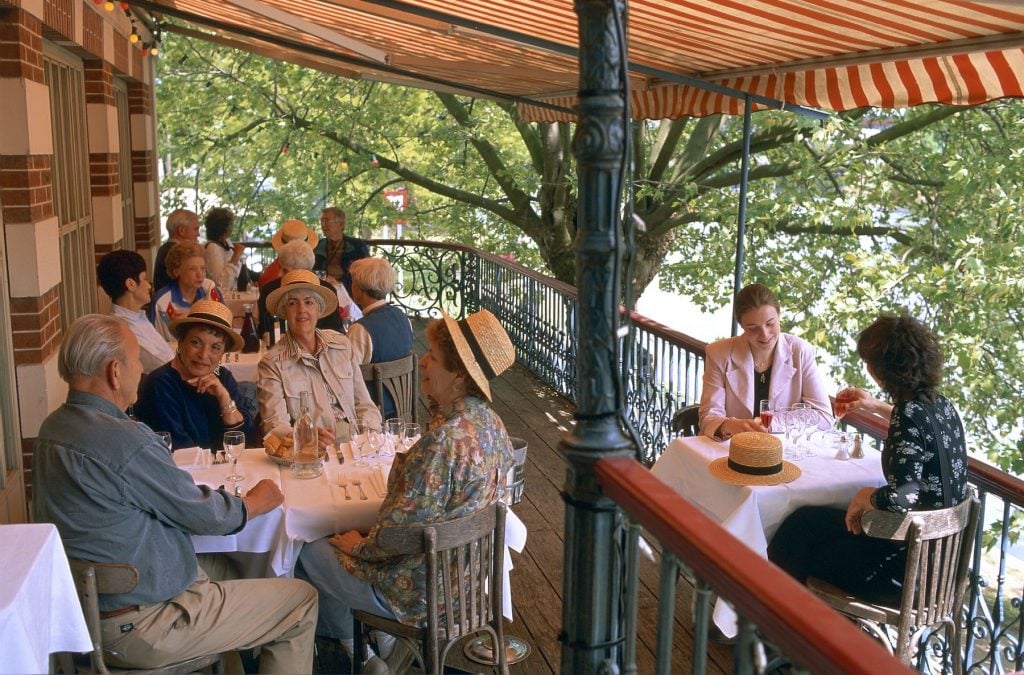
Maison Fournaise, the open-air cafe where Renoir painted The Luncheon of the Boating Party. Photo by Jarry/Tripelon/Gamma-Rapho via Getty Images.
Discussions of the painting logically often center on the depicted figures—some of Renoir’s nearest and dearest friends. For instance, the young man clad in a straw boating hat and singlet at the lower right-hand corner is fellow Impressionist Gustave Caillebotte.
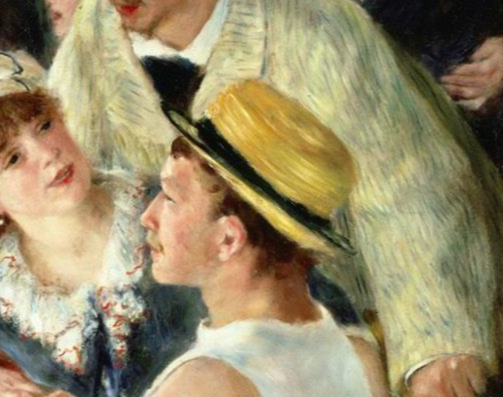
Detail of Renoir’s Luncheon of the Boating Party, depicting Gustave Caillebotte.
The woman pictured drinking in the middle is Ellen Andrée, an accomplished actress who was also the model of Degas’s Absinthe Drinker.

Detail of Renoir’s Luncheon of the Boating Party, depicting Ellen Andrée.
Perhaps most famously, the woman on the left, with the flowered bonnet and puppy, is Aline Charigot, Renoir’s then-girlfriend and future wife (he infamously scratched out another sitter to include her face).
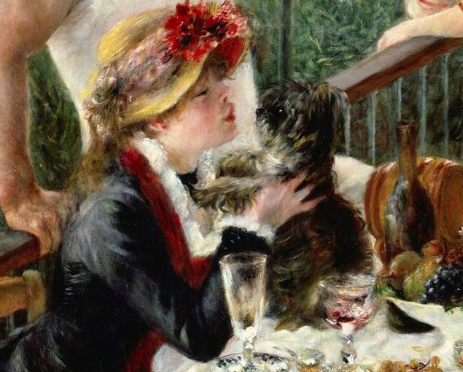
Detail of Renoir’s Luncheon of the Boating Party, depicting Aline Charigot.
But there’s more to know about The Luncheon of the Boating Party beyond these basics. Here are three more facts that might change the way you look at it.
Even Renoir found the process of creating this large painting convoluted, writing in 1880: “I no longer know where I am with it, except that it is annoying me more and more.”
An accident may have actually helped him break through. Four months in, Renoir took a tumble on his bicycle and broke his dominant right arm, forcing him to work with the left. Having to work in the new way seems to have inspired him. Writing to a patron, he said, “[I]t’s even better than what I did with the right. I think that was a good thing that I broke my arm. It allows me to make progress.”
He’s not the only one who thought that the switch up gave him a special finesse. Some twenty years later Camille Pissarro wrote to his son: “Didn’t Renoir, when he broke his right arm, do some ravishing paintings with his left hand?”
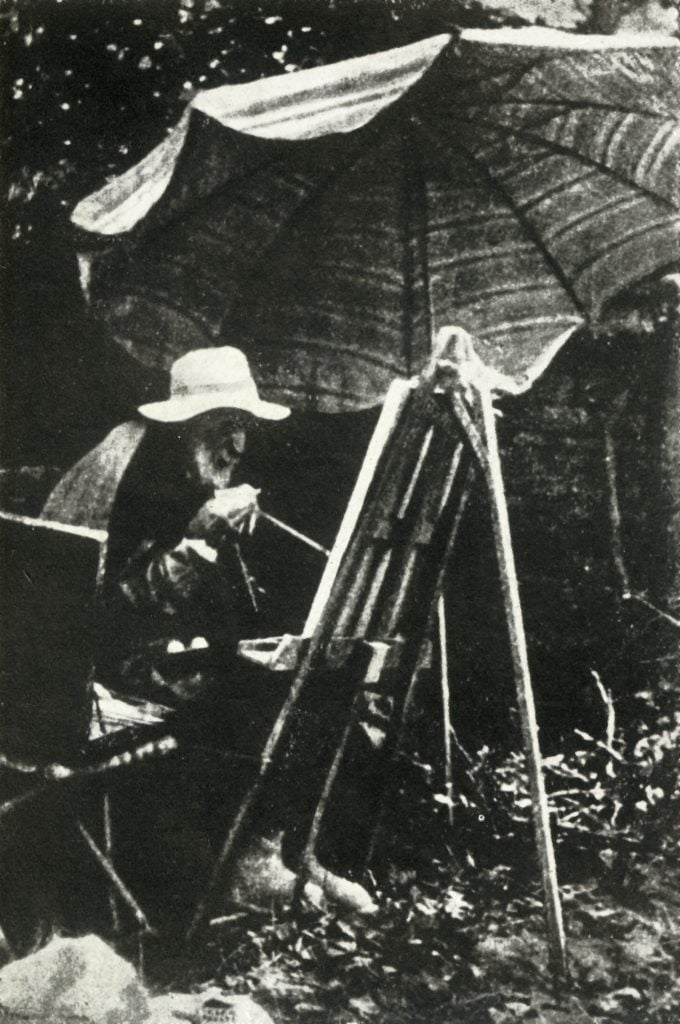
Renoir painting outdoors, circa 1910s, with his right hand. Photo by Print Collector/Getty Images.
“I vow this will be the last large painting,” Renoir exclaimed in a note to his patron Paul Berard. It would mark another finale in Renoir’s career too: the artist, who was dead broke, was concerned his association with Impressionism was too edgy, fearing it would cost him commissions. He was increasingly drawn to returning to more solid-bodied images.
Thus, this is his last truly Impressionistic painting—and you can see how it captures Renoir mid-stream, between two styles.
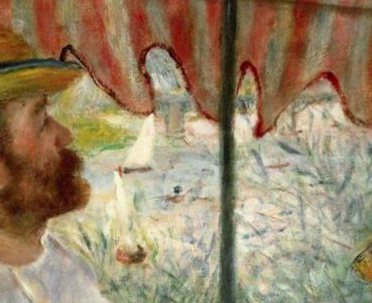
Detail of Renoir’s The Luncheon of the Boating Party, showing the boats in the background.
The sailboats in the background and the still life of bottles, glasses, and fruits on the table are rendered with quick Impressionistic energy.
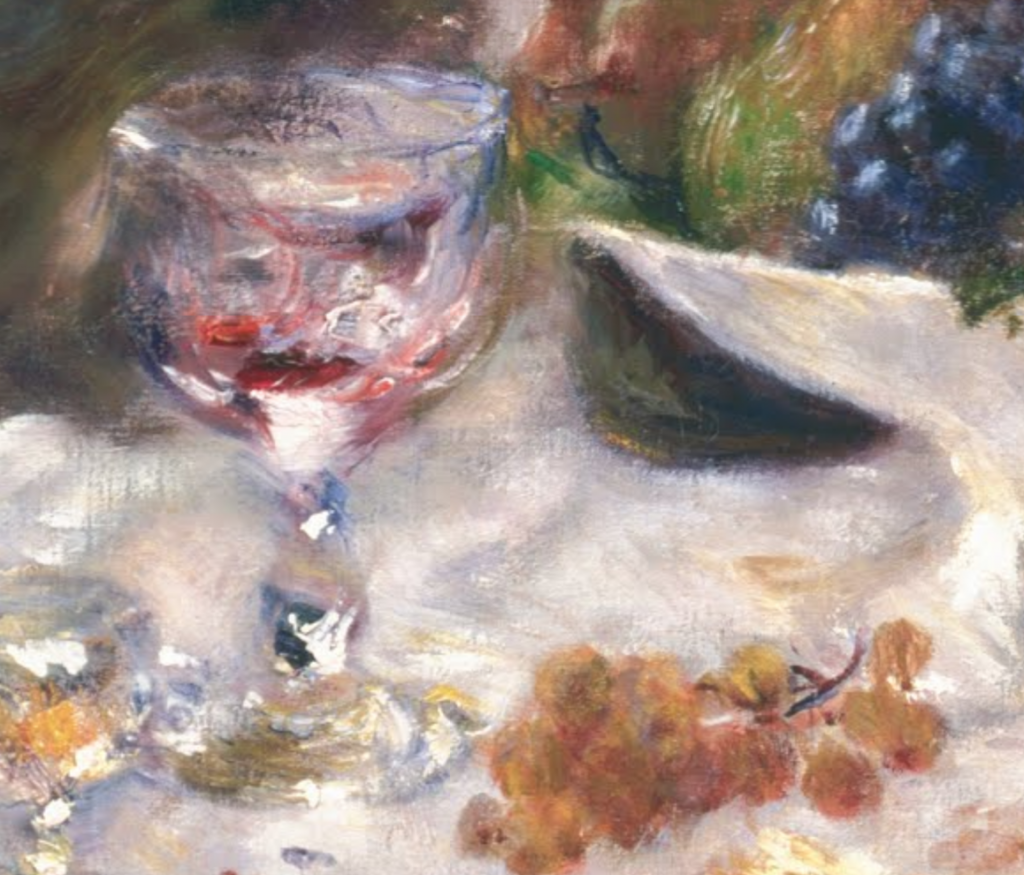
Detail of Renoir’s The Luncheon of the Boating Party, showing a glass and grapes on the table.
But the figures themselves, especially those closest to the foreground, are volumetric and defined. Caillebotte’s arm seems to jut into viewers’ space.
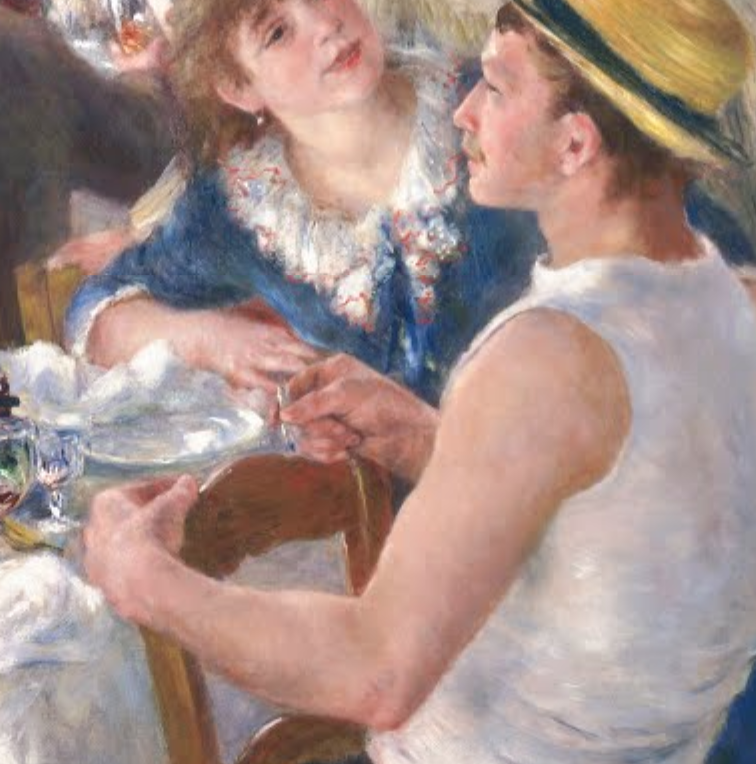
Detail of Renoir’s The Luncheon of the Boating Party, showing the solid modeling of a man’s arm.
Compare this with another of Renoir’s famed outdoor scenes, Bal du moulin de la Galette from five years earlier. There, the figures’ edges blend with overlapping, dashing brushstrokes into the larger canvas, appearing nearly blurred with motion and flattened into the background.
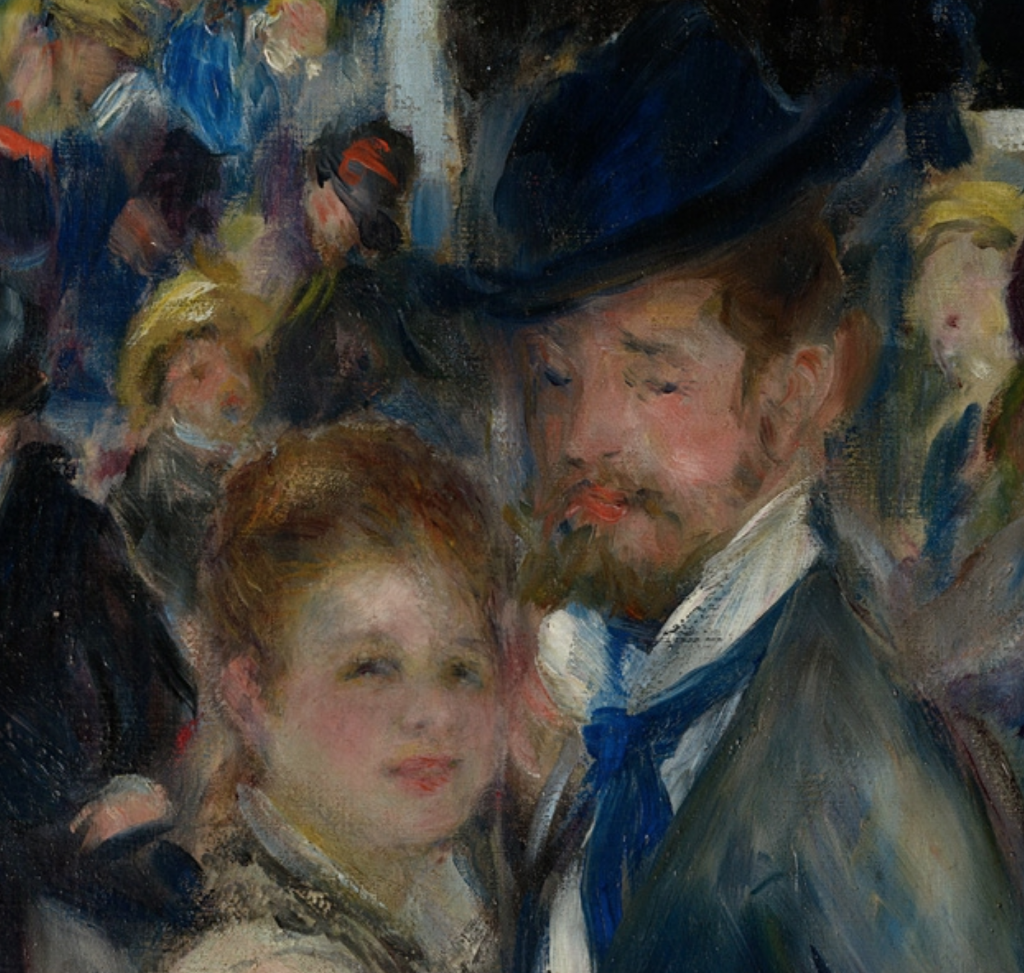
Detail of Renoir’s Bal de Le Moulin de la Galette, showing his more Impressionistic style.
This tendency toward volume and concrete shapes would only continue to heighten as time went on. After selling The Luncheon of the Boating Party to Paul Durand-Ruel in 1881, the (for once) financially flush Renoir traveled to Italy, finding inspiration in the art of antiquity and the Renaissance, ushering in the artist’s oft-maligned late period.
American collector Duncan Phillips spent some twelve years on a mission to acquire The Luncheon of the Boating Party, after first seeing the work while in Europe in 1911. In 1923 he purchased the work directly from Durand-Ruel for the then astronomical sum for $125,000, and it became the crown jewel of the collection.
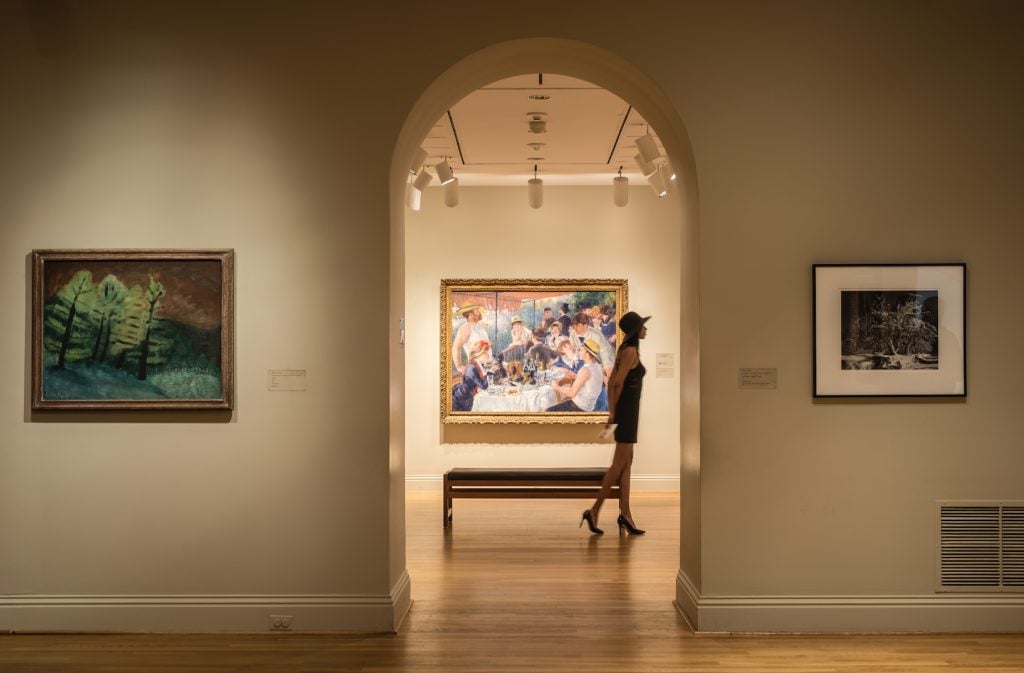
Renoir’s Luncheon of the Boating Party at the Phillips Collection. Photo by Andre Chung for The Washington Post, via Getty Images.
But in 1954 when Phillips sought out noted restorers Sheldon and Caroline Keck to repair a blister on the surface of the canvas. In the process, the restorers ventured to clean the canvas, with controversial results.
Former Time magazine art editor Alexander Eliot recalled later dropping in to see the painting during 1950s and being appalled by its changed appearance: “Its blossomy colours appeared dried out, droopy and half-awry. The seated figure in the foreground had been reduced to corpse grey.”
Eliot claimed to have confronted Phillips about the painting, and that “tears misted the sensitive old gentleman’s eyes,” after which Phillips confided that after the cleaning, “[t]he people at the Louvre at first refused to accept the resultant ruin as a Renoir!”
The Kecks adamantly defended their cleaning. They once said that Renoir’s son, upon seeing the “restored” work, remarked that it looked as it had in his childhood.
If you want to get a sense of how the restored Luncheon holds up next to Renoir’s original vision, Michael Daley of Artwatch UK has some side-by-side comparisons of before-and-after details. Judge for yourself which is more appetizing!